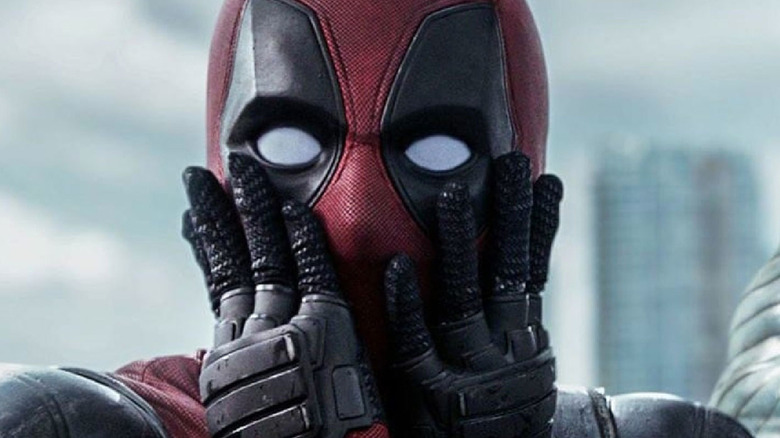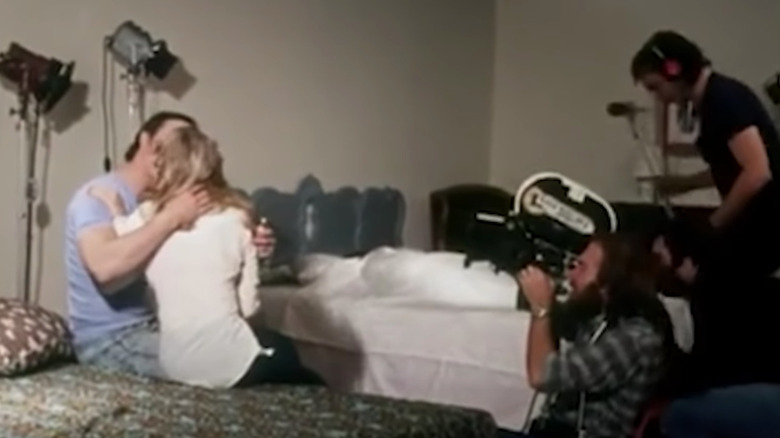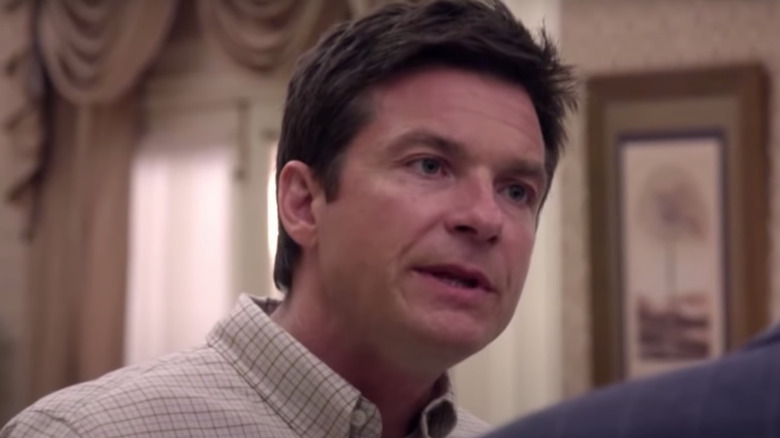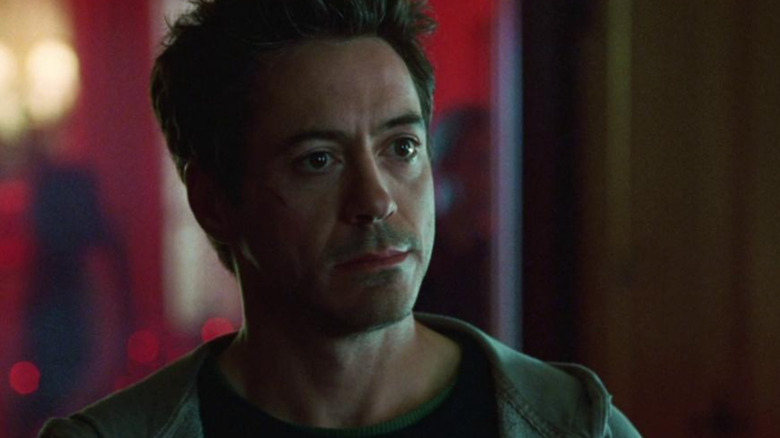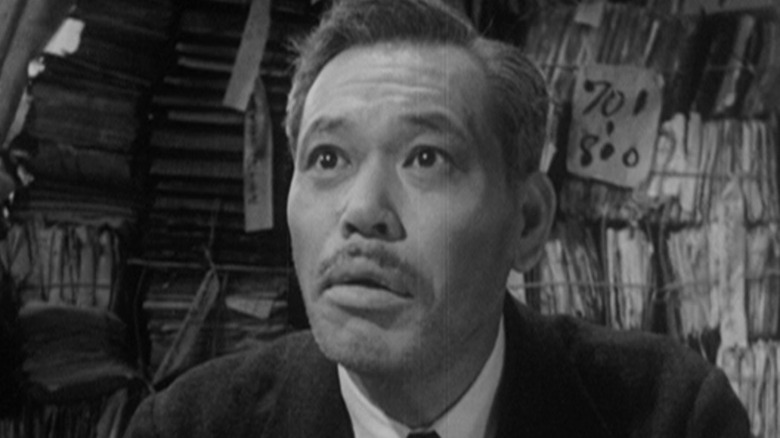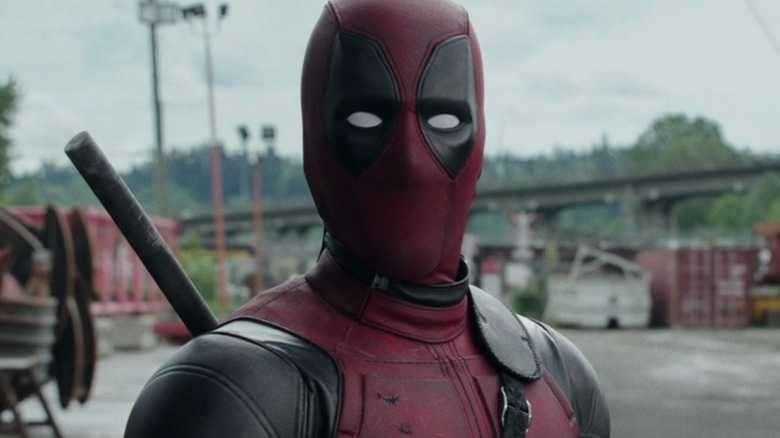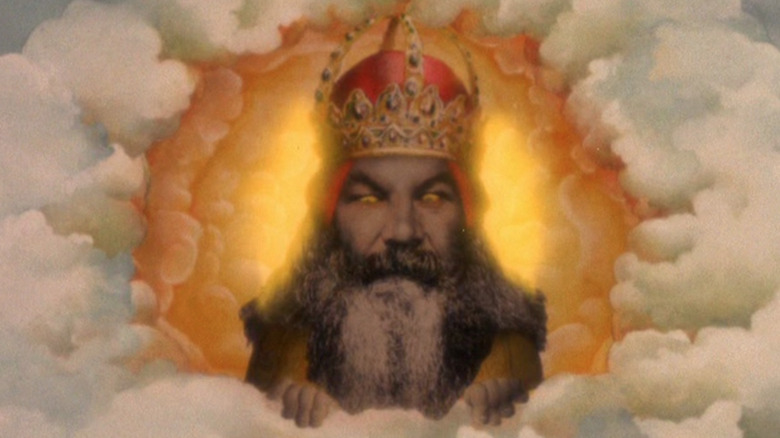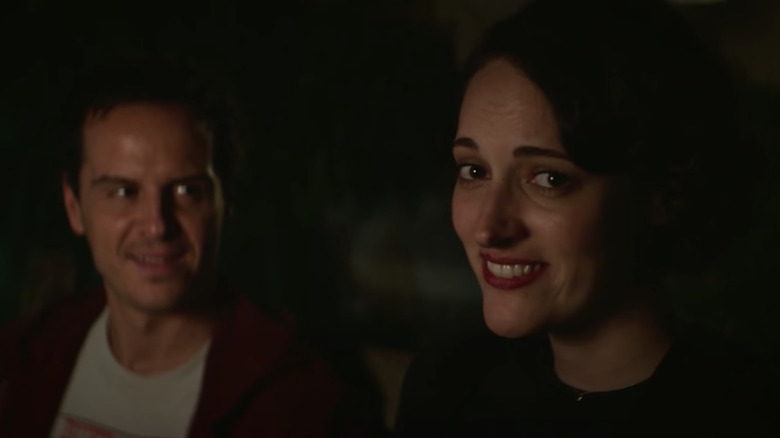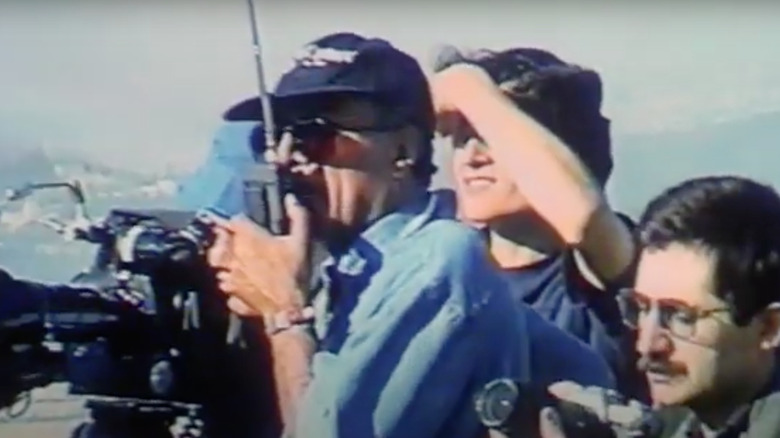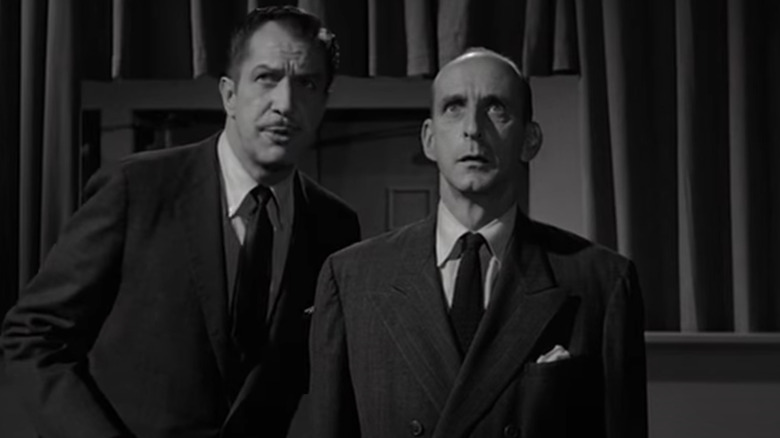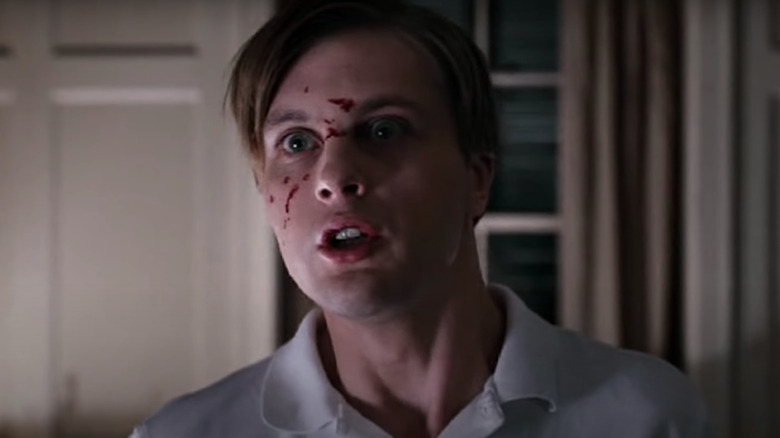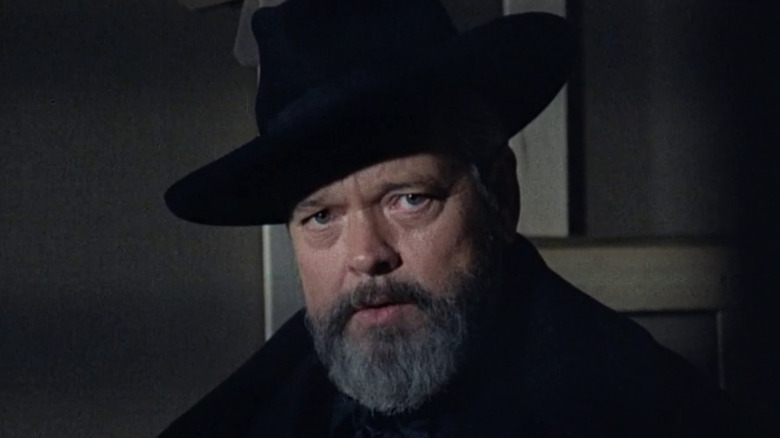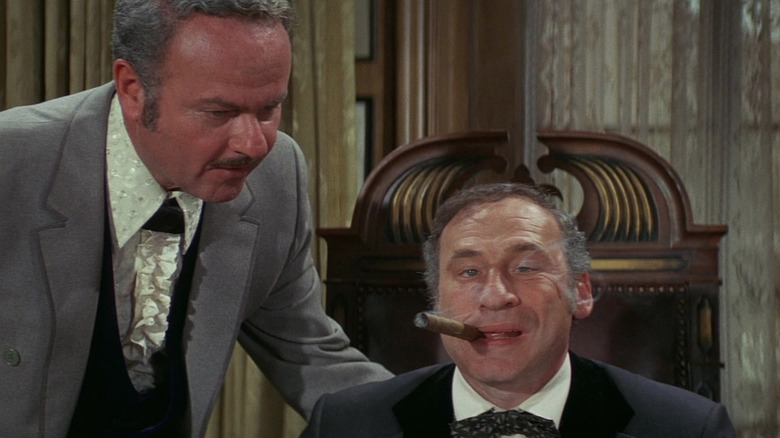Fourth Wall Breaks In Movies And TV Shows Ranked
The fourth wall as a concept stems from all the way back in the early 1800s, decades before the advent of photography, let alone cinema. The term refers to the imaginary wall between the performers and the audience in a theatre production. As a rule, although audiences can see the characters in a stage play, the inverse is not true, and the characters are unaware that they are a part of a work of fiction. Ignoring this rule and acknowledging either the audience or the artifice of a fictitious production is known as breaking the fourth wall.
The term eventually grew beyond its origins in theater and can now be applied to any work of fiction regardless of medium. Books can break the fourth wall, such as Mark Z. Danielewski's "House of Leaves," video games break the fourth wall, such as in "Metal Gear Solid" when Psycho Mantis reads the player's memory card, and, of course, movies and TV series can break the fourth wall in all manner of ways. The most common cinematic approach is when a character looks at and/or addresses the camera and audience, but there are countless other ways to break the fourth wall on screen. The following movies and shows shatter that invisible barrier either exceptionally well, or in the most daring, creative ways.
12. Snuff
"Snuff" is an absolutely terrible film and the lowest-rated of all the video nasties, but it does contain one of the most daring and memorable instances of breaking the fourth wall ever put on the screen. In the final scene, the main plot of this trashy exploitation film — about a gang carrying out Manson-esque murders — draws a to a close with a pregnant woman getting stabbed in a bedroom. The film then cuts wider, breaking the fourth wall by showing the entire film crew responsible for making the rest of the movie we have just watched and revealing that the bedroom is actually a movie set.
By acknowledging the fictional nature of the entire film that came before, this final scene is presented as reality. Two members of the film crew find themselves turned on by the fake violence, and things start to get sexual before quickly escalating to torture, dismemberment, and disemboweling with the entire film crew watching and participating. The movie then ends with the camera supposedly running out of film and without any credits rolling.
At the encouragement of distributor Allan Shackleton, rumors flourished that "Snuff" was a genuine snuff film and that the final scene depicted a real murder caught on camera. It probably goes without saying that the final scene is NOT a real murder, but this radical fourth-wall break had many people fooled: it led to the film earning a notorious reputation and garnering far more attention than it would have otherwise.
11. Arrested Development
"Arrested Development," which began as a Fox sitcom before being canceled and later revived by Netflix, makes use of a handheld, semi-documentary shooting style. The visual aesthetic of the show is similar to mockumentaries such as "The Office" or "Parks and Rec," but unlike those shows, "Arrested Development" only shares the visual presentation of a mockumentary, not the narrative implications. While the characters on "The Office" are aware that they are being recorded and give interviews directly to the camera, the Bluth family on "Arrested Development" does not acknowledge the cameras, and their most private moments are captured for all to see.
The fact that the series commits to its fiction the vast majority of the time makes the handful of occasions when the show does acknowledge the artifice all the more surprising and hilarious. Several episodes will go by without the show breaking the fourth wall, then the camera operator will suddenly be acknowledged when security guards prevent them from following the characters into a court room, pointing to a "no cameras allowed" sign. A dozen more episodes might pass before the fourth wall is broken again by narrator Ron Howard exclaiming, "Hey, that's the name of the show!" after a character says the words "arrested development" in casual conversation. The restraint shown by only indulging in these fourth-wall-breaking moments on rare occasions helps them stand out.
10. Kiss Kiss Bang Bang
2005's "Kiss Kiss Bang Bang" is a mashup of film noir and buddy comedy from writer-director Shane Black. The film was Black's directorial debut after working as one of the most prominent screenwriters in Hollywood throughout the 80s and 90s, even setting the record for the most expensive spec script sale with "The Last Boy Scout." For his first spin in the director's chair, Black didn't hold back, and he delivered a movie that is as ambitious as it is hilarious.
Though the film flirts with breaking the fourth wall through some of Robert Downey Jr.'s voice-over narration, it mostly stays in its lane and maintains its narrative reality. This all changes at the end of the film when Downey and Val Kilmer's characters address the audience directly. Downey completely dismantles the fourth wall, saying, "I'm just trying to wrap up the movie and leave the people with a message," before Kilmer covers his mouth, tells him to stop narrating, and says, "That's it, please stay for the end credits. If you're wondering who the best boy is, it's someone's nephew."
This funny, self-aware ending is reminiscent of the iconic post-credits scene in "Ferris Bueller's Day Off." While Ferris breaks the fourth wall constantly from the very beginning of the film, "Kiss Kiss Bang Bang" waits until the very last scene. This somehow makes it ever funnier, as if Shane Black reaches the finish line, then says, "Now all bets are off."
9. Ikiru
"Ikiru" is an example of a prestige drama breaking the fourth wall in an unorthodox manner. This highly-acclaimed Akira Kurosawa film tells the story of a red tape-entangled bureaucrat who only begins to lead a fulfilling life after learning that he has just a few months left to life. All of the characters within this deeply emotional story keep the fourth wall intact, but there is a character outside the story that breaks it.
The disembodied voice of a narrator is utilized in a handful of moments throughout "Ikiru." Rather than maintaining the artificial reality of the story, the narrator shines a light on the film being a work of fiction. When the narrator refers to the bureaucrat played by Takashi Shimura, he does not address him by his character's name, Kanji Watanabe. Instead, the narrator calls him the protagonist. The film even begins with the narrator introducing Watanabe as the main character in the drama that is about to unfold, acknowledging the artificial construction around the story from the get-go.
Even more strikingly, after Kanji's death partway through the movie, the narrator acknowledges the surprising nature of this development, saying, "The protagonist of our story has died," and reframing the last act of the movie as it continues on without him. Breaking the wall between viewer and film in this way invites analysis of the purpose of the narrator and the overall themes of the movie, while allowing for multiple interpretations.
8. Deadpool
There is no individual character more directly connected to the concept of breaking the fourth wall than Deadpool. Plenty of characters do it, but not many make it an intrinsic part of their identity. In both "Deadpool" movies and the comics that preceded them, the central character constantly addresses the readers or viewers with reckless abandon, looking into the camera and addressing the audience directly or commenting on the artificiality of his surroundings and the other characters in his orbit. Hardly a scene goes by without some type of a self-aware, meta humor that violates the fictional reality.
Given that Deadpool exists within the massive Marvel universe, his fourth wall incursions are even more noteworthy when compared to the dozens of superheroes and villains who never make that leap. There are other Marvel characters who break the fourth wall in the comics, but Deadpool's self-aware antics are more of a rarity on screen — though he does have some competition from the title character of the Disney+ series "She-Hulk: Attorney at Law."
7. Monty Python and the Holy Grail
From the moment the very first episode of "Monty Python's Flying Circus" aired on British television in 1969 to the end of their cinematic output, the Monty Python comedy troupe was always pushing the envelope and finding new ways to break all of the rules. The A.V. Club remarked that in the work of Monty Python, "the fourth wall is so flimsy and so frequently shattered that it might as well not exist." Even though their sketch comedy television show had already broken the fourth wall in dozens of inventive ways throughout its four seasons, the Pythons' meta antics reached their apex in their first all-original feature film outing, "Monty Python and the Holy Grail."
From intentional anachronisms to the coconut clip-clopping in place of actual horses, this irreverent comedy is jam-packed with brilliant moments of subversion. In a movie full of memorable fourth-wall breaks, the best of all might be when the knights escape a vicious monster because the animator drawing it has a heart attack and dies mid-scene. Even the opening credits are loaded with an entire series of escalating jokes directed at the audience before any of the cast members ever appear on screen. The craziness of the film eventually boils over with the ultimate break in its closing moments, by having modern-day police arrive, arrest the main characters, and smash the camera.
6. Fleabag
"Fleabag" — which aired for two seasons on BBC One in the U.K. and Prime Video in the U.S. — is the brainchild of creator and star Phoebe Waller-Bridge. This two-time BAFTA-winning and six-time Emmy-winning dramedy show is a masterclass in writing, performance, and addressing the viewers directly. The complicated titular character, played by Waller-Bridge, frequently says one thing while thinking and feeling opposed or unrelated thoughts. She expresses these by turning and speaking directly to the camera mid-scene, sometimes switching back and forth several times in a single conversation.
This main internal-monologue convention is executed well enough to earn "Fleabag" a spot on any list of noteworthy shows that go meta, but the concept is pushed even further in the second year. While Fleabag is the only person who speaks to the viewers throughout the show, Season 2 introduces a priest character, played by Andrew Scott, who becomes the first and only person to notice when she breaks the fourth wall. He isn't aware of precisely what is happening when she turns to the camera and addresses the audience but he knows something is up. "Where did you just go?" he asks after she speaks directly to the camera in the middle of their conversation, prompting confusion and concern on Fleabag's part and raising thought-provoking questions for the audience.
5. Taste of Cherry
"Taste of Cherry" is a Palme d'Or-winning arthouse drama from acclaimed Iranian writer-director Abbas Kiarostami. The deliberately-paced story concerns a suicidal man in search of someone he can pay to bury him beneath a cherry tree after he ends his own life.
There is quite a bit of cinematic experimentation in "Taste of Cherry" and the biggest swing by far arrives at the very end of the movie. The film cuts to black, with the main character in his grave. Then, after a quiet pause, the film fades back in, now shot on a lower-resolution digital camera. Instead of continuing the story, viewers are treated to something akin to a behind-the-scenes look at the making of the movie. Kiarostami, his film crew, and even the lead actor all take center stage, completely undoing the fictional reality of the story that was just told in the previous 90 minutes. In an interview with IndieWire, Kiarostami acknowledged that this fourth-wall-breaking ending was a huge risk that he knew would divide audiences, but felt it was a risk worth taking, saying, "I like it because it means the movie hasn't ended."
If you or anyone you know is having suicidal thoughts, please call the National Suicide Prevention Lifeline by dialing 988 or by calling 1-800-273-TALK (8255).
4. The Tingler
"The Tingler" is a cheesy 1950s horror B-movie from director William Castle, who was known as the king of movie theater gimmicks. Vincent Price stars as a doctor who has a radical theory that fear is caused by a parasite that lives within every human being. In the movie's reality, he is correct, and this parasite is the titular Tingler, which attaches itself to people's spines and causes a tingling sensation. Near the end, the Tingler finds its way into a movie theater, which is where the film breaks the fourth wall in exceptionally inventive fashion.
When the film opened in 1959, a number of elaborate stunts were orchestrated by Castle and his team and carried out with the cooperation of movie theater employees. About 10% of theater seats were equipped with so-called "Percepto" devices – actually repurposed surplus aircraft motors — in advance of screenings of "The Tingler." As the film cut to black, Price's voice would address the audience, announcing "The Tingler is loose in THIS theater!" At that precise moment, the Percepto-equipped theater seats would vibrate, giving unsuspecting audience members the sensation of being attacked by the Tingler as Price encouraged them to "scream for your lives!" The film would also be stopped altogether and the house lights would come up at a pre-planned moment, as paid audience plants would pretend to faint and be carried out on stretchers by faux nurses. Sadly, this type of interactive fourth-wall breaking is pretty much a thing of the past and doesn't happen in modern theaters.
3. Funny Games
"Funny Games" is an 1997 Austrian thriller from filmmaker Michael Haneke, who directed a shot-for-shot remake of his own movie in English a decade later. The two versions are nearly identical, although they utilize different locations and casts, and as such they both break the fourth wall in the same radical manner. The effect is no less jaw-dropping on a second time around.
The title of "Funny Games" is extremely misleading. This is a dark and disturbing story about a family being taken captive and tortured by a pair of psychopaths who want nothing other than entertainment from their victims. After an extended period of sadistic violence, the psychopaths finally have the tables turned on them, and one of them is killed by a shotgun. The film then breaks the fourth wall in a truly outside-the-box and intentionally frustrating way by having the other psychopath use a remote control to literally rewind the scene and regain the upper hand, preventing the family from gaining any advantage in the first place.
This is a challenging and unexpected moment that uses the concept of breaking the fourth wall in a new and thought-provoking manner. The rewind may leave some viewers feeling cheated or just plain confused, but it is without a doubt sure to linger in every viewer's mind long after the film has ended.
2. F for Fake
"F for Fake" is a groundbreaking hybrid of narrative, documentary, and cinematic essay from 1973 by filmmaker and star Orson Welles. As explained by Peter Bogdanovich in the Criterion release, the film presents itself as a documentary about forgery, artifice, and all things "Fake," but in keeping with its theme, many aspects of this supposed documentary are entirely fictitious and fall more in line with a traditional narrative film. The lines of truth and fiction are blurred so thoroughly throughout the course of "F for Fake" that attempting to separate the two becomes nigh impossible, and that's exactly the point.
In a film that is constantly peeling back layers of reality and unreality, the very notion of breaking the fourth wall is flipped on its head and turned inside out. The rug is constantly being pulled out from underneath the audience as this Russian nesting doll of an experience unfolds. Camera crews are revealed, artificial sets are displayed, and sequences presented as reality are in turn exposed as having been meticulously staged, as Welles meditates on what it means for something to be fake and revels in revealing that fakery to the audience.
1. Blazing Saddles
Similar to the Monty Python comedy troupe, the career of Mel Brooks contains a wealth of brilliant fourth-wall-breaking moments, any number of which could earn a spot on a list such as this is. But Brooks never pushed the idea further than in his 1974 Western parody, "Blazing Saddles." The story is set in the Wild West and follows a dastardly politician and his plot to run a town into the ground by appointing the nation's first Black sheriff, which backfires immediately.
While the entire film is packed with Brooks's signature over-the-top (and often raunchy) humor, things get more and more ridiculous and self-aware as the story progresses. The film eventually comes completely apart at the seams as the entire landscape of the movie's reality disintegrates and the characters bust out of their Western set and onto the Warner Bros. studio grounds, rampaging through backlots, cafeterias, and other film productions. When it seems as though the line between fiction and reality couldn't be more thoroughly demolished, Brooks keeps on going by having the main characters travel to a movie theater and attend the premiere screening of "Blazing Saddles" — the very movie they've escaped from. The fourth wall isn't just broken, it has blinked entirely out of existence.
